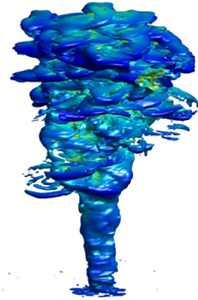Article contents
Numerical investigation of starting turbulent buoyant plumes released in neutral atmosphere
Published online by Cambridge University Press: 13 August 2020
Abstract

A fundamental study has been conducted to understand the mean and turbulence characteristics and their role in mixing processes of starting turbulent plumes initiated by a heated area source and released into a neutral atmosphere. Large eddy simulation has been performed in a domain of size 7 km (vertical) and  $4~\text {km} \times 4~\text {km}$ (horizontal) for five different cases with surface heat flux varying from 0.5–2.5 km s
$4~\text {km} \times 4~\text {km}$ (horizontal) for five different cases with surface heat flux varying from 0.5–2.5 km s $^{-1}$. With increasing buoyancy flux, the plume Reynolds number
$^{-1}$. With increasing buoyancy flux, the plume Reynolds number  $Re$ (based on the maximum centreline velocity) increases from
$Re$ (based on the maximum centreline velocity) increases from  $6 \times 10^{7}\text {--}10^{8}$; however, the Froude number
$6 \times 10^{7}\text {--}10^{8}$; however, the Froude number  $Fr$ does not increase monotonically with increasing
$Fr$ does not increase monotonically with increasing  $B_o$, it varies from 1.091–1.149. Key physics that contributes to mixing and entrainment of ambient fluid into the plume has been investigated. The buoyancy- and shear-production of turbulence kinetic energy contributes to the mixing processes within the plume. The characteristic features of a starting plume are: the presence of a spiralling columnar neck region surrounding the central core that extends to
$B_o$, it varies from 1.091–1.149. Key physics that contributes to mixing and entrainment of ambient fluid into the plume has been investigated. The buoyancy- and shear-production of turbulence kinetic energy contributes to the mixing processes within the plume. The characteristic features of a starting plume are: the presence of a spiralling columnar neck region surrounding the central core that extends to  $5D$ (
$5D$ ( $D$ is the source diameter), and which is capped with an unsteady head region that actively entrains fluid due to instabilities at the plume interface. Formation of vortex rings and instability mechanisms are linked to the entrainment process. Unsteady entrainment has been calculated using first principles, and the results revealed that entrainment, though negligible initially, initiates with the growth of the instabilities in the head region of the plume, and it correlates with the local Reynolds number in the head region.
$D$ is the source diameter), and which is capped with an unsteady head region that actively entrains fluid due to instabilities at the plume interface. Formation of vortex rings and instability mechanisms are linked to the entrainment process. Unsteady entrainment has been calculated using first principles, and the results revealed that entrainment, though negligible initially, initiates with the growth of the instabilities in the head region of the plume, and it correlates with the local Reynolds number in the head region.
JFM classification
Information
- Type
- JFM Papers
- Information
- Copyright
- © The Author(s), 2020. Published by Cambridge University Press
References
REFERENCES
- 14
- Cited by


